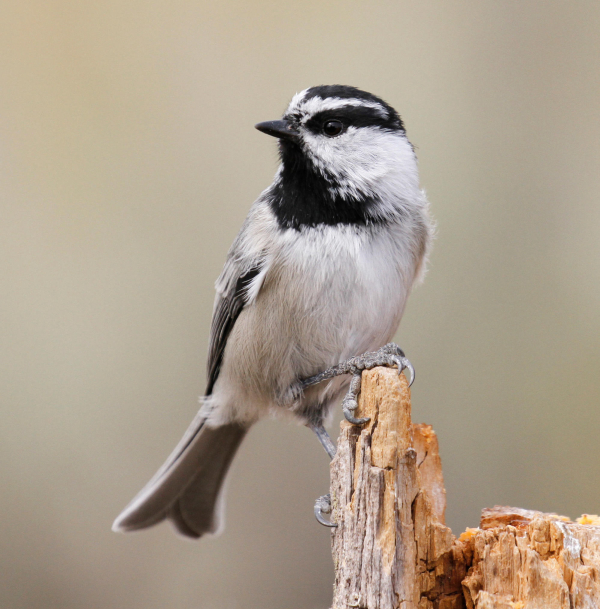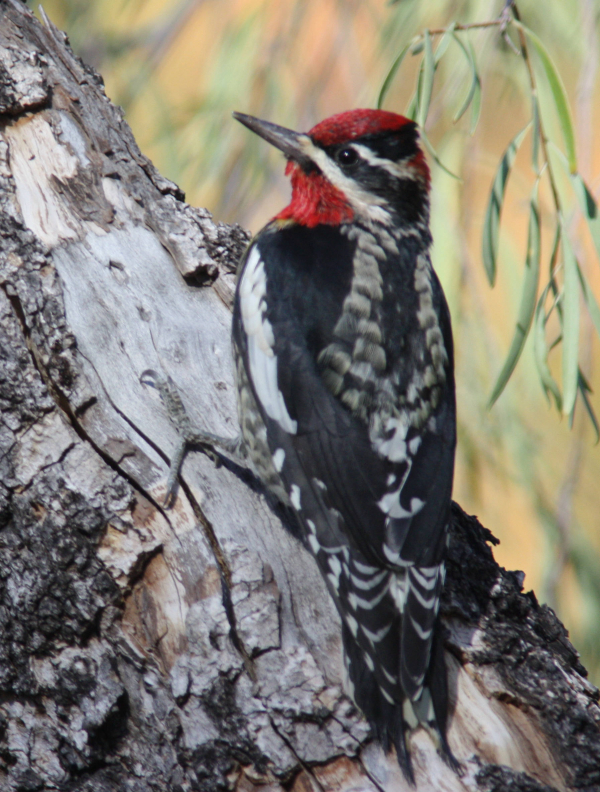
Mountain Chickadees are emblematic of the interesting movements of several species from the eastern Rockies to southwest portions of the Great Plains (photo by Robin Agarwalt).

Steller’s Jays (above), Pinyon Jays, and Woodhouse’s Scrub Jays have been among the most obvious mountain birds to spread into the southwest plains.

Some evidence of woodpecker movements eastward include sapsucker species, including Red-naped Sapsuckers. Will more follow?
|
Birders Be Aware: Just as we watch for northern finches and other birds that are moving south in significant numbers this year, very interesting information is accumulating that indicates mountain birds are moving onto the Great Plains, especially the southwest region of the Plains. By mid-October this irruption was mostly concentrated in southeast Colorado, southwest Kansas, and the Oklahoma and Texas panhandles, but there’s no telling how far traditionally montane birds might range this fall. It all started with Mountain Chickadees, Steller’s Jays, Pinyon Jays, and Woodhouse’s Scrub Jays, as described in an article authored by Alec Hopping, which is published on the American Birding Association’s website in its Field Ornithology series.
Of the mountain species that are being documented beyond their normal ranges, Mountain Chickadees and Woodhouse’s Scrub Jays have been the most prevalent. Both have become somewhat common in towns and woodlots in parts of Cimarron County, Oklahoma; Dallam County, Texas; Morton County, Kansas, and surrounding areas. By mid-October, Woodhouse’s Scrub Jays made it as far east as Garden City, Kansas.
Even Steller’s Jays have made it as far east as Hugoton, Kansas, and while Steller’s are rare winter visitors in the Oklahoma panhandle some years, this season’s October 5th arrival date is exceptionally early. Multiple Steller’s Jays have also been documented on the plains of Cimarron County, Oklahoma and Morton County, Kansas, where they are even rarer.
Pinyon Jays have also been observed far to the east: In Kansas the first sightings of Pinyon Jays since 2003 were reported in Morton County on October 5th, and in Hamilton County on the 9th. In Texas, where Pinyon Jays haven’t been documented since 2017, one was photographed and in Dallam County on October 4th, and there have also been records on the eastern plains of Colorado in areas where the species is less than annual.
As in much of the East, Red-breasted Nuthatches and Pine Siskins are being reported across most of the southwestern Great Plains this fall. Scarcer finches have also been documented in higher numbers than normal: Evening Grosbeaks have been recorded in Bent County, Colorado (September 24), Yuma County, Colorado (October 10), Hamilton County, Kansas (October 9), and Cimarron County, Oklahoma (October 5). As evidence of their rare occurrence in Oklahoma, keep in mind that Evening Grosbeaks are a review species in that state.
Cassin’s Finches have already appeared more often than previous years since at least 2017, with multiple records in Dallam County, Texas (October 4 and 6); Texas and Cimarron Counties in Oklahoma (October 5 and 9); Morton County, Kansas (October 18), the adjacent plains of Union County, New Mexico (October 11), and Baca County, Colorado (October 4).
A Williamson’s Sapsucker, also a review species in Oklahoma, was observed in Cimarron County from September 13 to 15, and another Williamson’s Sapsucker was found just a mile from the Oklahoma border in Baca County, Colorado on October 6th. Western migrants including Red-naped Sapsuckers, Cassin’s Vireos, and Townsend’s Warblers were also reported in higher numbers than usual for October. At the subspecies level, the first eBird records of “Rocky Mountain” Downy Woodpeckers were documented in Kansas and Oklahoma, as well as the second record of this Downy Woodpecker race in Texas.
The eastern limit of this movement of birds from the eastern Rocky Mountains into the southwest Great Plains is difficult to define due to the low density and uneven distribution of birders and birding coverage that region, which is one of the most sparsely-populated areas in the Lower 48 States. Birding coverage in the region is biased to where rare birds have already been reported, and because almost all of the birders who venture into the area live 4+ hours away. That makes questions about the nature and extent of the mountains-to-plains event difficult to explain.
How far east could some mountain species venture this year? Will this irruption accelerate, or have we already observed its peak? Could it be possible to find even scarcer mountain species, such as Clark’s Nutcrackers, Pine Grosbeaks, or even American Three-toed Woodpeckers? The only way to find out is for birders across the central part of North America, north to south, to go birding with mountain species on their radar this fall. It will certainly be interesting to follow this topic in the weeks and months ahead!
The original article, authored by Alec Hopping, was originally published on the American Birding Association’s website as part of its Field Ornithology series, which you can access at https://www.aba.org/montane-species-irrupt-onto-great-plains-fall-2020/
Share your birding experiences and photos at editorstbw2@gmail.com